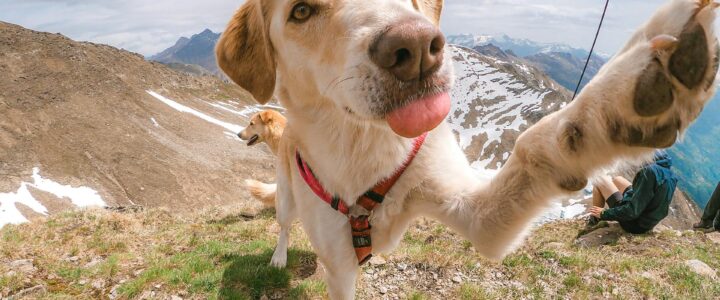Nobody expects a pet to go missing … but you can be prepared should it occur.
More Common Than You Think
An emergency can range from a medical situation where you can’t care for your pet to a major environmental catastrophe where an evacuation which could result in separation from your pet.
If something suddenly happened, how prepared are YOU to provide safety and care to your dog or cat? Prep plans are important for humans and animals alike.
As we have recently been reminded, natural disasters can dramatically and unexpectedly put ourselves and our pets at risk of separation.
Beyond environmental emergencies, preparing to protect your pet can be as simple as taking steps to minimize potential pet risks for routine situations.
Recognizing the potential risks and creating best practices will allow you to be more confident that you have been proactive to try to mitigate risks.
How It Can Happen
It can happen quickly and unexpectedly. Consider these simple, yet frequent scenarios.
– A visitor opens the door a crack and your pet goes out. During yard repairs your gate is left open.
Or a child inadvertently lets your pet outside.
– Car rides. It can be as simple as how you take your dog in the car to the vet or on a vacation.

How many times do we see dogs delighted by hanging out the car window taking in the smells and feeling the breeze! Or on the driver’s lap while doing so. As much as you may want to indulge, consider the horrific end result that might occur should an abrupt stop or a collision occur. What might happen to your beloved pet?
While any collision can result in an injury or even worse, consider the fact that just as humans wear seat belts to minimize potential injury, so too can restraints for our pets.
In fact, the Center for Pet Safety provides test results for a variety of pet restraints.
– Pet walker or sitter who is unfamiliar with your pet can unwittingly not grip a leash solidly enough or a dog may slip out of their
collar or leash. You could be miles away and get that frantic call that your pet is loose and missing.
– You’re walking your dog and they see a deer. pull hard, and you lose grip of the leash as they dart off.
– You’re not at home and there’s an emergency like a fire, and the emergency responders have to gain entry and your pet runs out in the process.
All of these are real possibilities. Should any of them occur, having been prepared with a collar, tag and microchip could play a major role in your potential reunion.
Collar with ID tag and registered microchip are a dynamic duo!
COLLAR AND ID TAG
A pet with a collar and ID tag is immediately the fastest way for a lost pet to be reunited. And keep your contact info on the tag current. Rabies tags or shelter tags can also assist. But the quicker someone can pick up a phone and reach out to a frantic pet owner the better.
REGISTERED MICROCHIP
A microchip that is REGISTERED is essential. Don’t assume that the microchip is registered. Have your pet scanned by your vet and verify it can be read and that it is registered with up-to-date info. A secondary contact is quite helpful to have on file. If your pet is NOT chipped, get it done.
Check out pricing of microchipping clinics, as they may be more cost effective than your vet. But when paying, make sure to find out if YOU need to register the chip, or if the fee is including registration.
Important to understand that a microchip is NOT a tracking devise. However, if registered, when your pet is found and their microchip is detected you can be contacted via the info provided during registration. Be sure when you move or change your phone number to update this info!
Also, while a rescue may come with a microchip that is registered to the rescue, make sure YOUR info is added!
Rescues are volunteer organizations and some may close up over time. Plus, you want to be reunited as quickly as possible, so your number should be the first place a finder would call.
ADDITIONAL CONSIDERATION: GPS TRACKING COLLARS
A more recent addition that some may consider are GPS tracking collars. Visit our “May We Recommend Page” for a link to start exploring GPS tracking collar options available for dogs and cats alike. These can be helpful, in locating your pet, but are not a replacement for your collar/ID tag and microchip combo.
If Your Pet Goes Missing
Nothing is more heartbreaking than a beloved pet that goes missing.
When it happens any pet owner is in a state of panic, yet quick response is vital.
While there is no SINGLE database to post or search for a lost or found pet, PetcoLoveLost is one major database to utilize to report lost or found pets. Their free database coordinates with many shelters nationwide, and they assist with flyer design and resources.
PetFBI is a free database that works with various lost pet State FB pages that interface with Lost Dogs of America. This network of experienced volunteers assist owners of lost pets with designed flyers and tips to assist.
FLYERS WORK!
Essential and often the MOST HELPFUL as you begin your search are effective signs that are put up as quickly as possible. While it requires manpower, it is probably the most effective way to get the word out and start to get sightings which are essential to narrow down where your pet is located.
Here are some other tips to consider:
– Contact your local shelter(s), even ones 60 miles away. Also go IN to check local shelters, don’t always just rely on written descriptions of strays or surrendered pets, especially if your pet is not microchipped
-Contact your pet’s microchip company if chipped. Also make sure the chip is registered and your contact info is updated. Keep it updated no matter how long your pet is missing.
-Make flyers/signs and start getting them out into the area where your pet went missing. Try to enlist friends and neighbors to help you get the word out.
-Create a FB page for your lost pet that others can share.
-Reach out to area veterinarians/ER vets, pet supply stores, and doggie day care companies with flyers.
-If your area has NextDoor or other community networking options utilize them to get the word out as well.
-Consider having friends place signs about your lost pet in their car windows to serve as moving advertising for you.
-If you’ve lost a cat, reach out to area TNR groups in case your cat finds their way into a cat colony being fed.
-If you happen to see your lost pet, do not yell out their name or go running towards them. Sit down and don’t give direct eye contact. Once a dog is on the run, they go into survival mode. See video below.
Emergency Prep Before It’s on your Doorstep
Evacuation planning
Emergency preparedness for your pets is essential for yourself AND your pets should you find yourself in the path or a storm or other environmental disaster. What can you do to prepare and what steps should you take?
Get started by reading some tips and checking out some links provided below.
Pet Safety Resource Links

Additional Pet Safety Considerations
Can No Longer Provide Care for Your Pet
If you couldn’t care for your pet due to some medical situation or emergency housing circumstance, who would care for your pet?
Sadly many shelter surrenders are the result of pets who don’t have anyone who can step up to fill that role.
Pet Trusts or, at the very least, sincere conversations with family members and friends related to who might step in to assist with your pet is vital.
Health Related Emergencies
Are you prepared with info/resources should your pet need immediate care? In addition to your emergency vet, it is helpful to be familiar with Pet CPR.
The Red Cross offers training in Pet CPR. Find an online class.






